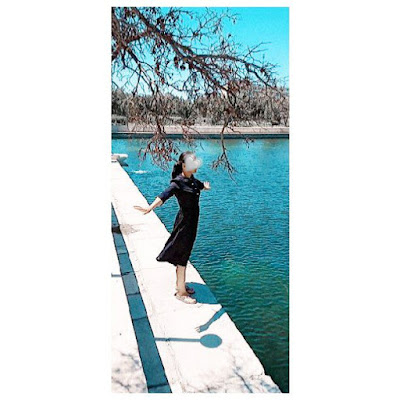Memorial Complex of Imam al-Bukhariy
Hello, everyone!
This is me again🙋
Today our trip was in Memorial Complex of Imam al-Bukhariy.
Let's talk about it
Muhammad al-Bukhari was born in Bukhara, and lived between 810-870. His father was a scholar of the hadith (sayings of the Prophet Muhammad), and as a teeneger he started recording these sayings which were passed verbally at the time. He traveled to Mecca at sixteen, and also visited other holy cities over a long period including Medina, Jerusalem, Damascus, Bahgdad and Basra. He used this period to interview religious leaders of these holy cities and record hadiths. It is reported that he received more than 500,000 hadiths, and returned to Bukhara in his 30's.
On his return he compiled 7,275 of the tested hadiths in a book known as "al-Jami' as-Sahih". This book is represented on the monument. The book is considered second only to the Koran by Sunni muslims. The museum highlights his travels, text collection and other interesting facts on the book. For his work, the imam received the title, "Master of Hadith Scholarship". The book was used as the basis to judge rulings on religious issues. The Imam died at the age of sixty in a small village named Hartang, near to Samarkand. His mausoleum is located 30 km north of Samarkand, and is a place of pilgrimage.
There are many attractions in the Samanid Park including the Zoo, Talipach Gate, Ismael Somoni mausoleum and the lake which offers a wide variety of activities. This area may be reached by walking west from the old city through the east gate of the park, taking a bus to Mirdustim Street and walking in a northerly direction or taking a bus to Sulaymon Murodov Street and walking east along the ancient wall to access the park.
One of the most prominent hadith scholars of the Muslim world, Imam al-Bukhari, was born in Bukhara on July 21, 810, and died in the village of Khartang (present-day Chelak district of Samarkand region), 25 km from Samarkand, where he was buried in 870. However, this place has been abandoned for centuries.The complex was restored with the Independence of Uzbekistan. On April 29, 1997, a Decree of the Government of the Republic of Uzbekistan "On the celebration of the 1225th anniversary of the birth of Imam al-Bukhari according to the Hijra-lunar calendar" was adopted. In November of the same year, the UNESCO General conference adopted a resolution on participation in 1998 in the celebration of the memorable date - the 1225th anniversary of the birth of the scientist Ismail al-Bukhari. In this regard, a memorial complex was built at the tomb of Imam al-Bukhari, made in the traditions of ancient architecture of Central Asia. The total allocated area of the monument is 10 hectares. The complex is adjacent to the Samarkand-Imam al-Bukhari highway (25 km).Mausoleum of Imam al-BukhariThe construction of the complex and landscaping works were carried out under the leadership of the President of the Republic of Uzbekistan Islam Karimov. Folk craftsmen from Samarkand, Bukhara, Khiva, Tashkent, Andijan, Kokand and Shakhrisabz participated in the construction of the complex. On the basis of national architectural traditions, a mausoleum, a mosque, an administrative building and others were built.The main facade of the administrative building of the complex faces to the south. The entrance to the complex is made through three large carved gates of the arched structure. The main entrance through Darvaza-khana is built with an arched large terrace in the national style. On the front part of the entrance portal, the text of the history of the construction of the complex is written in Arabic and Uzbek. At the entrance of the big Darvaza-khana, on the right, there are administrative and other rooms. The mausoleum of Imam al-Bukhari is located on the central axis of the complex. This cube-shaped structure is topped by a seventeen-meter dome. The walls are decorated with light green, blue, white glazed tiles, marble, onyx and granite. On the right, under the light blue onyx tombstone (Sagan) of the upper floor, there is the grave of al-Bukhari, covered with marble. On the left side of the courtyard there is a mosque with an area of 786 sq. m. The total area of peshayvans is 214 sq.m. 1500 worshippers can pray in the mosque at the same time.
At the mihrab niche hangs the Kiswa – the covering of the Kaaba, presented to the President of Uzbekistan Islam Karimov by king of Saudi Arabia Fahd bin Abdulaziz Al Saud. In the left side of the courtyard is a hall with utility room (miyansaray). The dome of miyansaray like other domes of the same size and volume. This building houses the library, research staff offices, and other rooms. Its total area is 946 sq. m. the library contains unique samples of manuscripts of the Koran, various editions, as well as samples of the work of Imam al-Bukhari.
Next to the Imam al-Bukhari complex is the building of the Imam al-Bukhari International center, founded by the decree of the President of the Republic of Uzbekistan Islam Karimov on May 23, 2008. The Imam al-Bukhari complex is one of the largest and most unique structures of this type created in our country in recent centuries. This complex, as President Islam Karimov said, is not only a place of holy worship, it is one of those places in Uzbekistan that glorifies our homeland and plays an important role in the education of the younger generation, makes every person think about life and eternity.
The end!










Very colourful 😀 🤩
ОтветитьУдалитьThanks for your precious information and useful speech 💓💖✨🥰💕💞😇😊😀
ОтветитьУдалитьBest❤😊
ОтветитьУдалить😇😇🤩🤩👍👍👍
ОтветитьУдалитьGood job
ОтветитьУдалить